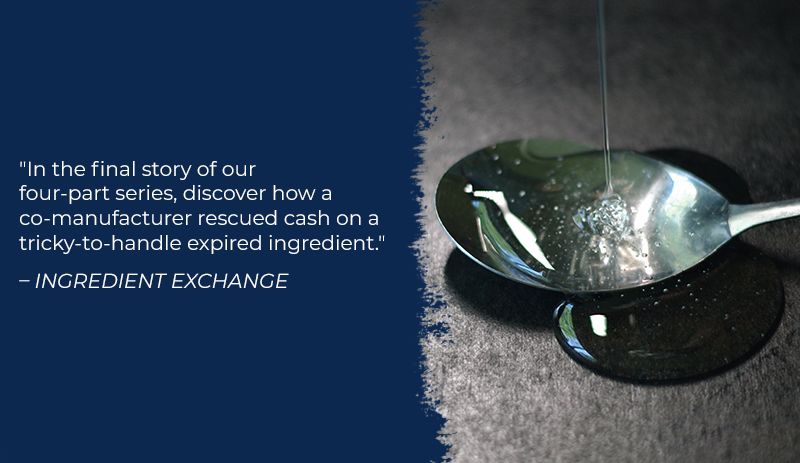If you have expired invert sugar in your facility, you may know that it’s not as easy to recover as its dry cousin, extra fine granular (EFG) sugar.
Unlike expired EFG — that can be pushed back through the refinery — invert sugar syrup creates handling challenges, such as heating the product to make it pumpable and getting the correct valves for the packaging type.
Consequently, the recovery percentage for invert sugar syrup tends to be lower.
That’s where selling the expired product comes in.
In the final story of our four-part series about food industry businesses reducing loss on their problem inventory, discover how a co-manufacturer rescued cash on an expired ingredient and transformed it into a higher-value non-food application.
The shift-in-production challenge
When a co-pack manufacturer’s production strategy changed, they were left with surplus inventory.
The excess product included several truckloads of expired invert sugar syrup — around 160,000 pounds. Because the liquid sugar had passed expiration, the product’s value was dropping rapidly.
| TIP While invert sugar has a two-year-plus shelf life, using the product within six months will reduce the risk of crystalization. |
Also, the syrup was packaged in cardboard totes, requiring heating and specialized valves to open the plastic bladder and pump out the product.
There’s a non-food application for that!
Some products are a good fit for non-food applications and yield an excellent return (such as specialized feed applications).
Sugar (in general) is a great candidate for non-food uses. It’s added to livestock feed as an energy source and has industrial uses in detergents, types of cement, and glues.
For the manufacturer’s invert syrup, we were able to work with our existing buyer network to find an application outside the food industry.
Also, the co-manufacturer took three key actions that set them up for a successful selling process. That included:
1. Supplying pictures
The product owner snapped images of the labels and the product. The photos provided compelling visual proof of the product’s quality — no professional photography needed.
2. Providing a trial load
Providing the trial load allowed the buyer to determine if the product was a good fit. They liked what they received in the first load and purchased the remaining inventory.
3. Acting quickly on the expired product
It’s ideal to start the selling process a few months before expiration. While the syrup had expired, the product owner was proactive in repurposing the sugar.
The expired invert sugar outcome
The Ingredient Exchange team got to work and handled every stage for selling the manufacturer’s expired ingredient — from finding a buyer to arranging the freight. For the copack manufacturer, that meant:
A fast turnaround
From the initial communication to the final shipment, the process took around forty-five days. The manufacturer’s images and organized verification documents contributed to the swift transaction.
A healthy cash return
The product owner recouped more cash than the traditional amount you’ll see for expired food ingredients.
Note: This was a special circumstance. By reprocessing the sugar as a higher-end feed application, the seller received a significant percentage of their investment. Not all expired ingredients yield such a desirable return.
Minimal effort
For the co-manufacturer, the selling process required little effort; they supplied the documents and photos, and we took care of the rest. That included providing updates throughout the selling process — from initial communication to completion of the project.
Additionally, we were able to assist the seller with the totes valves — to ensure that moving and pumping the syrup went off without a hitch.
Final thoughts
Discovering that food inventory has expired is not great. However, with the help of an ingredient management company, you’ll avoid:
- Using valuable warehouse space to store the problem ingredient
- Working out how to put the product back in the system
- Tapping into critical internal resources to handle the product (such as allocating the task to staff and keeping them from their work).
Above all, you’ll recover cash on unusable inventory.
The co-manufacturer was able to sell their expired invert sugar syrup quickly and get a healthy return with minimal effort by working with the Ingredient Exchange team.
At Ingredient Exchange, we solve complex ingredient problems for food businesses. Do you have expired inventory that you need to dispose of with minimal effort and get a return?



